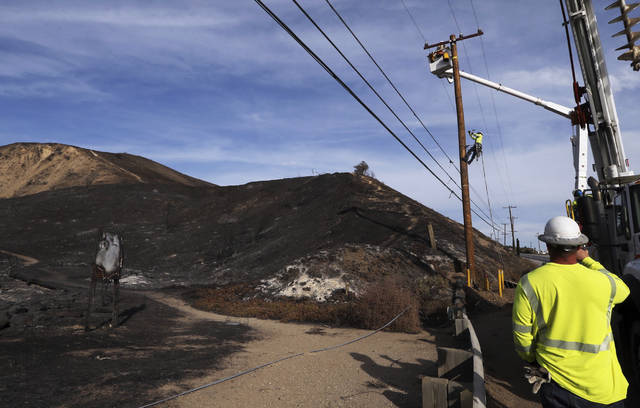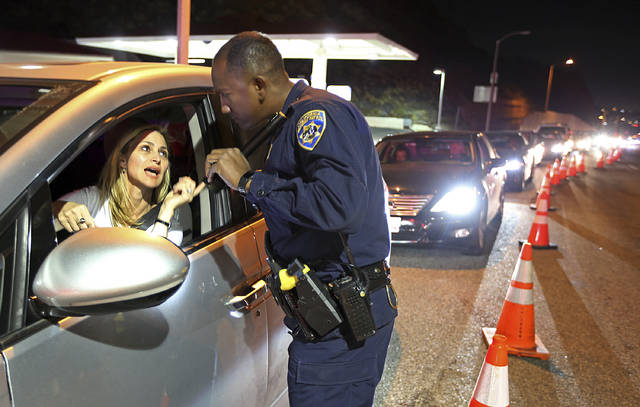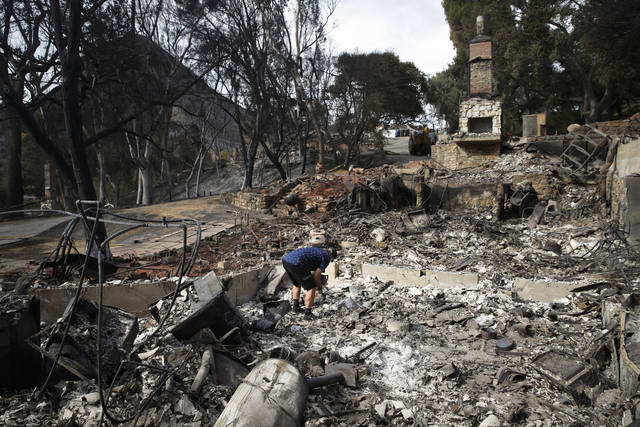MALIBU, Calif. — Southern California’s huge wildfire flared before sunrise Wednesday in rugged mountain wilderness as winds buffeted parts of the region, but forecasts called for a decline in the withering gusts.
The flare-up occurred near the western end of the Santa Monica Mountains, sending a huge column of smoke out to sea, but was burning in uninhabited wilderness parklands well away from communities.
The National Weather Service said winds would slack off sufficiently during the afternoon to allow authorities to lower wildfire warnings from their highest “red flag” levels. Forecasters cautioned, however, that very low humidity levels would keep danger levels at “elevated,” or a notch below the red flag level.
The weeklong blaze in Ventura and Los Angeles counties was 47 percent contained after scorching more than 152 square miles (394 square kilometers), engulfing homes, scenic canyon getaways and celebrity estates, officials said.
Authorities allowed residents back into several more communities on Tuesday, including a section of Malibu. Other areas have been repopulated since the weekend. As many as 250,000 people were ordered out at the height of the fire.
Officials tempered optimism with caution, saying there were hotspots and pockets of unburned vegetation that could ignite.
“We are not out of the woods yet. We still have some incredibly tough conditions ahead of us,” Ventura County Fire Chief Mark Lorenzen said Tuesday.
The death toll from the so-called Woolsey fire stood at two — a pair of adults found last week in a car overtaken by flames. They have not been identified.
The number of homes and other structures destroyed had reached 435 but that number was sure to rise, warned Los Angeles County Fire Chief Daryl Osby. Damage assessments were continuing, with crews having to gain access to canyon areas on foot.
Some people who stayed behind in coastal communities that were cut off by road closures got supplies by boat. Gas, food, baby wipes and horse pellets were among the items brought ashore in the Paradise Cove area of Malibu. Some residents donned wetsuits and swam ashore with cases of water and beer.
“It’s pretty cool. It’s really amazing that people out there know that we’re kind of stranded here in Malibu,” Cherie Millford Smart said.
In addition to homes and other buildings, more than 80 percent of National Parks Service land in the Santa Monica Mountains National Recreation Area was incinerated.
The area has not seen such a destructive blaze since 1993. The blaze has left an array of hazards, including trees ready to fall, downed power lines, toxins, water main and gas leaks.
A forecast of possible rain next week would help firefighters but also raised the prospect of potential mud flows, Osby said.
Another fire that also broke out last Thursday in Ventura County was 92 percent contained after burning nearly 7 square miles (18 square kilometers). The so-called Hill fire destroyed two buildings and damaged two.
A new fire erupted late Tuesday about 75 miles (121 kilometers) to the east in the Fontana area of San Bernardino County but firefighters reported good progress overnight, holding the blaze to 147 acres (59 hectares).
The cause of the Southern California fires remained under investigation.
Downed power lines and blown transformers have been blamed for several of the deadly fires that have burned in recent years.
A lawsuit was filed Tuesday over a wildfire in Northern California, where at least 48 people were confirmed dead in the Camp Fire that obliterated the town of Paradise. The suit on behalf of some victims accuses Pacific Gas & Electric Co. of causing the massive blaze.
A landowner near where the fire began said PG&E notified her the day before the wildfire that crews needed to come onto her property because some wires were sparking.
———
Myers reported from Thousand Oaks. Associated Press writers John Antczak and Christopher Weber contributed from Los Angeles.




